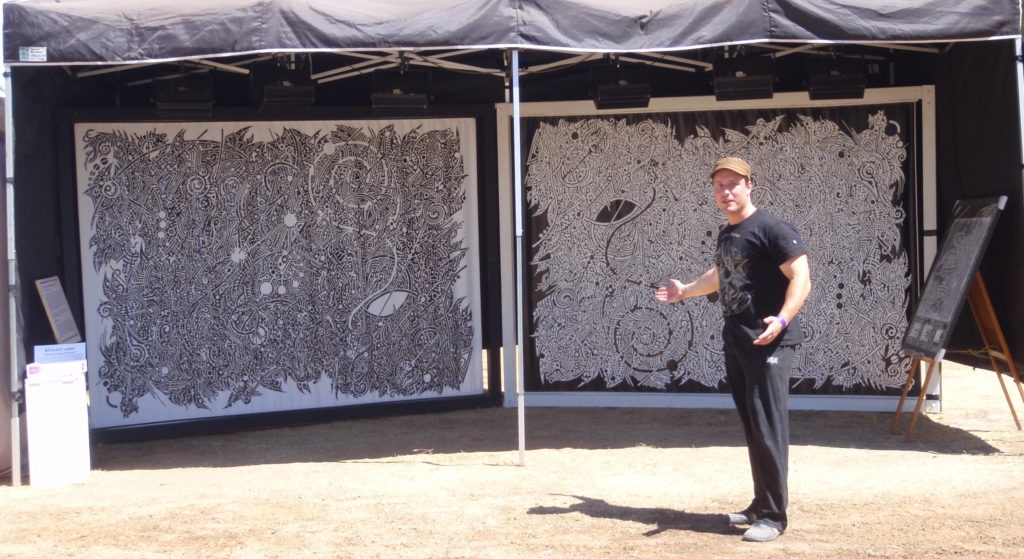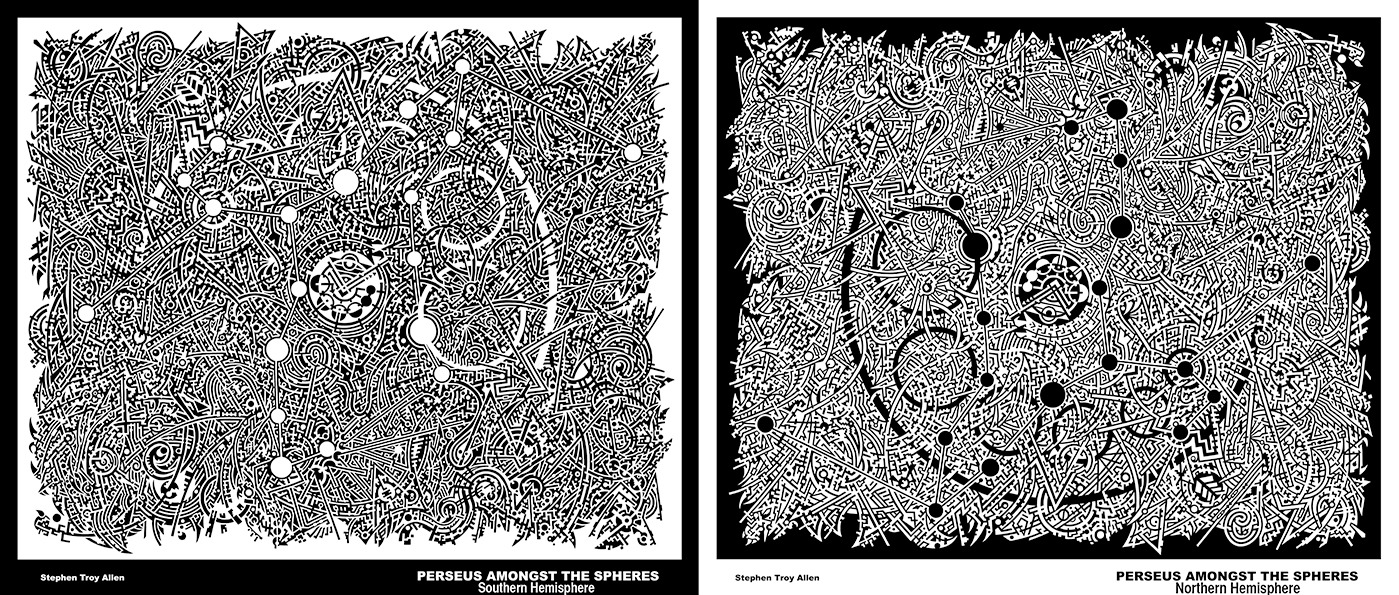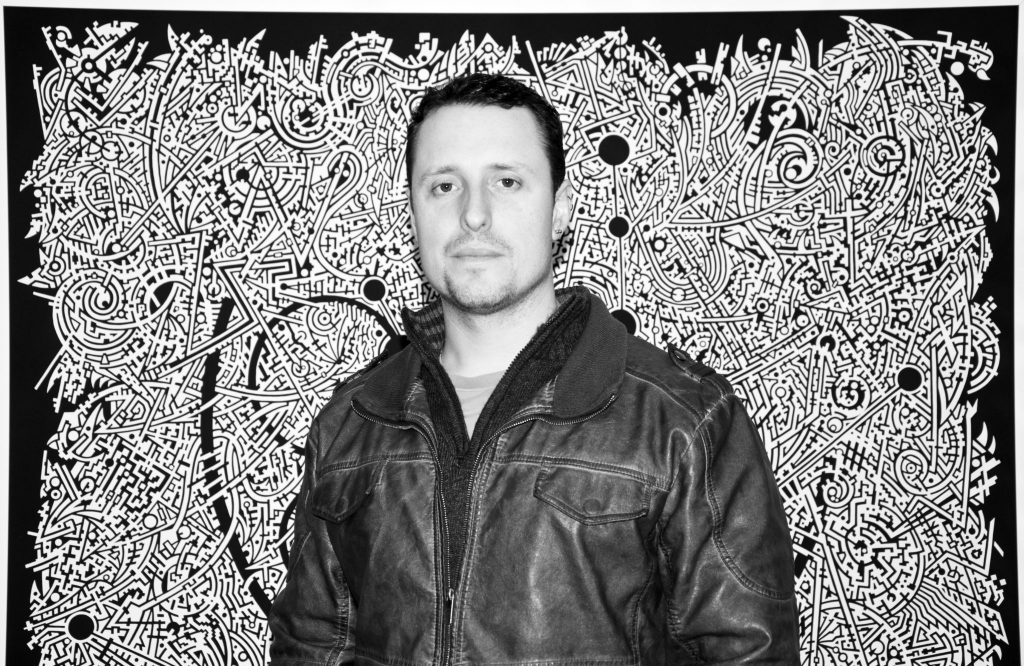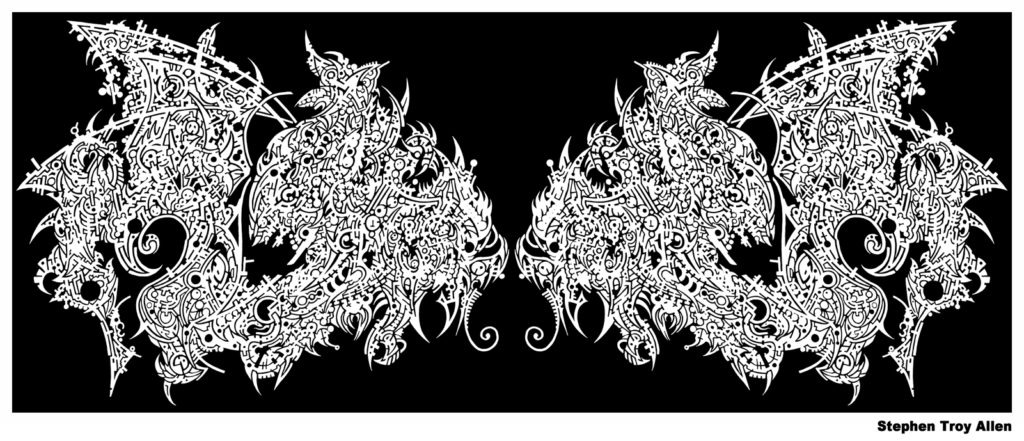We talked to Stephen Troy Allen who is the creative behind the D-Addiction ‘Out Of Sync‘ album artwork, and what ensued was a brilliant conversation. It’s always interesting to pick the brain of an artist such as Stephen, whose work is the result of conscious thought that results in beautiful, honest and relative work. He chats to us about the city of Melbourne, working in black and white, his back to basics style, and what he has planned for the rest of the year.
Your personal interests description on your fanpage reads like a Dr Seuss inspired short story for adults, reflective I’m guessing of your eccentric and non-conformist style and personality. Is there any set of particular reasons why you choose to use black and white to express yourself?
In developing a style that explores black and white, my choice to begin with the non-colour black is wholly ascetic, for I am deliberately restricting myself and embracing the challenge to create complexity from two-dimensional abstract black lines. It is simply black on white. I have no lavish palette from which to choose, and I am embarking upon a work that is extremely tedious, meticulous and ultimately meditative. Yet, the intent is to create something that is endlessly interesting, infused with kinetic energy and never the same image twice. This is simply the task of a human with a pen, a vision, and a laborious process before him – an aesthetic born from asceticism: a spiritual practice. Both ‘The Pelt of Pythagoras Muse’ and ‘Perseus Amongst the Spheres’ each took approximately seven months of constant drawing and neither could have been realized any quicker with the aid of a graphic design program. Each line had to be drawn by hand and calculated by a human deciding the exact interaction between pen tip and paper. My style is an attempt to get back to the basics, to consolidate an aesthetic into a vision, and a vision into an aesthetic, and to present an antithesis to the overreliance on digital gimmickry that is commonplace in the exploration of Visionary Art motifs. Essentially, it is a bold attempt at something new – a new form of visual language, a “writing” that emerges by virtue of its presence against a white backdrop, much like script on a page, or musical notes on a sheet. It is black contrasted with white, and white demarked by black – opposites harmonized.

How does living in Melbourne, Australia set the framework for what you do as a creative?
Melbourne has embraced its multiculturalism perhaps better than anywhere else, with a synergism of ethnicities contributing to a vibrant bar, club, restaurant and café culture. It is literally a city of world-class coffee shops and caffeinated conversations. These public “spaces” foster social connectivity and are an undeniable component of Melbourne’s unique creative soul. This all contributes to a favorable cultural clime for those aspiring to develop and discover themselves artistically. There is a unique urban verve that exists because it has not been controlled, or mismanaged by the Council Planners. One such example would be Melbourne’s Street Art scene, which is exceptional by international standards and flourishes largely with the blessing of Melbourne City Council. Art is generally acknowledged as an integral part of Melbourne’s identity. All of this instills a sense of hope in the artist.
As a Visionary Art practitioner, I have connected with Melbourne’s’ alternative ‘dance culture,’ a thriving scene that celebrates the psychedelic/enlightening potentials of Electronic Dance Music and the coming together of likeminded people. Such a scene is represented in numerous venues, and is supported by a large community of dedicated individuals who also attend large multi-day outdoor festivals throughout the year. I have had numerous opportunities to display large-scale reproductions of my artworks in the context of these gatherings.
The artwork that you did for D-Addiction’s ‘Out Of Sync’ is inspired and beautiful. What was the concept behind this and what sort of direction did Adi give you?
The original artwork intended for ‘Out Of Sync’ (which is included in the album’s booklet) was a much larger piece titled, ‘Universal Seed.’ In this work I attempted to depict the unseen quantum energies that underpin the very fabric of the “physical” Universe. This depiction took the form of a schematic code of geometric complexities expanding infinitely outward from the central “seed.” The white lines may be interpreted as the Divine Consciousness emerging to creatively express and experience itself against a backdrop of inert blackness – all which exists. This “blackness” represents the non-existence of the Void – all which never existed. In this context, the very existence of the Universe is the result of certain energies being ‘out of sync,’ with the Void, and thus, consciously creative.
Unfortunately, it was too vast and intricate to be fully appreciated within the spatial limitations of a CD album cover. This was problematic, and we agreed that a certain section needed to be selected, cropped and modified for best effect. Adi chose to overlay a photo that brought a spectrum of greenish-blue hues and an appropriate visual and emotional depth to what had previously been just white lines. The addition of colour evokes emotion and that is perfectly compatible with the effect of music. I was only too content to allow the cover image to evolve as a final collaborative piece, and although the white lines are gone and the artwork significantly altered, the overall concept of Creation being ‘out of sync’ with the Void is still represented.
You have various other interests other than art, such as writing and philosophy. Who are some of your most recommended writers and why?
I have always had a curiosity for esotericism and Eastern Mysticism. I am presently captivated by the ideas explored in the Russian teachings of George Gurdjieff and his pupil, P.D Ouspensky. In particular, Ouspensky’s classical account of Gurdjieff’s teachings, ‘In Search of the Miraculous.’ During his extensive travels in Asia in the early twentieth century, Gurdjieff purportedly discovered fragments of an ancient knowledge of self-transformation. Gurdjieff posited that a ‘fourth way’ existed — a way distinguishable from that of the Monk, the Yogi or the Fakir, but a spiritual path nonetheless, and a path that enabled one to not retreat from the world, but rather to embrace it, and to use the ‘shocks’ of the human condition as a means to understand that we are machines, and that true consciousness required a superhuman effort to overcome the default ‘automaton’ mind. Of course it is far more complex than this, but the idea that the mind can be refined through diligent and strenuous effort to isolate the lies that maintain the ‘automaton mind,’ surely appeals to an artist with a style such as mine.
You’ve been on the receiving end of an impressive number of awards. How do you feel about awards ceremonies and trophies? And what sort of value do you allocate to them both personally and career wise?
It would be true that most artists desire a certain ego nourishment, or rather, an acknowledgement that their creative efforts are valued and appreciated beyond their own desire for catharsis and self-satisfaction. It is important to the creative process – if not absolutely essential – that a completed work is seen and experienced by others and impressions are noted – either positive or negative. Indeed, this comprises the necessary “fuel” that often gives impetus to future creative endeavors. Now, if an award serves to amplify exposure and connect the artist with other like-minded individuals, or more importantly, the artwork with other like-minds, then it has an inherent value. However, if awards are merely a means to perpetuate and celebrate a closed-nepotistic-circle of privilege that certain art “movements” and “scenes” invariably have, then such awards have little true value. Much like such art.

We are half way through 2015 with much behind us and much before us. What can be expected from you from now until December?
I have always regarded my artworks as latent blueprints for future works that will evolve into manifestations and visions beyond the original piece. I am looking at some of the accessible technologies available, and currently creating digital concepts for the implementation and effective use of these technologies as reimagined artworks. Imagine ‘The Pelt of Pythgoras’ Muse’ carved into a massive rectangular slab of sandstone, perhaps as a bas-relief or engraved into the surface, lit with museum lighting and resembling a monolithic alien artifact recovered from an archeological dig on Mars; or perhaps a salvaged control panel from a crashed UFO – featuring a stainless-steel surface with designs of ‘Perseus Amongst the Spheres’ laser cut into a light-box and illuminated from within by striking light-blue LED lights. I am hoping to realize these projects and more before the year is out!


